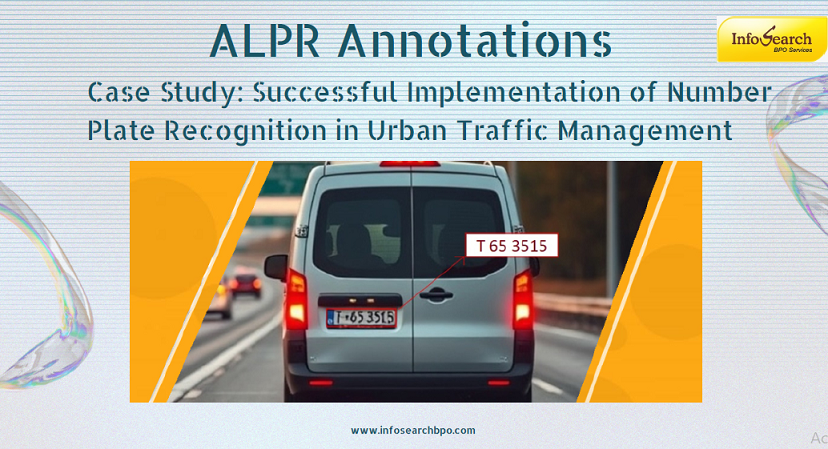Infosearch provides Automatic Number / License Plate Recognition services for machine learning. Our ALPR annotations results in enhanced and efficient security and police and car parking, toll and traffic control systems.
Number (License) Plate Recognition (NPR / LPR), Automatic Number (License) Plate Recognition (ANPR / ALPR), as an effective technology of urban traffic management has greatly enhanced traffic regulation, security, and even transportation system. Here is a case study that illustrates the benefits and outcomes of NPR technology in an urban setting:
Case Study: London United Kingdom Congestion Charge Zone Management
Being one of the most populated zones in the whole wide world, traffic jam, air pollution, and fewer numbers of roads have always been in controversy in London. In a bid to overcome these challenges, the Transport for London (TfL) introduced the Congestion Charge Zone in 2003 that levies drivers operating vehicles within central London during working hours. This system also experienced congestion issues and to effectively tackle the problem TfL have integrated Uses of number plate recognition which help to track and charge the vehicles in those zones.
Implementation of Number Plate Recognition:
TfL had fitted NPR cameras at the crucial locations throughout the CCZ to ensure the proper documentation of the cars getting into and out of the charge zone. The cameras mounted on towers at the entry and exit booms photograph the registrations of vehicles entering and existing respectively.
The ANPR system works to analyze the images captured and obtain the number plates then again compare with payment details. In the event that a vehicle has not paid the congestion charge, the system then creates a penalty notice that is issued to the registered owner of that vehicle.
Key Benefits of NPR in Urban Traffic Management:
- Reduced Congestion:
This paper argued that the introduction of the charge such as NPR contributed to the decrease in congestion around the central area in London. As a result of the clear identification of vehicles that had breached the congestion zone, TfL nudged drivers to search for other modes of transport than single occupancy car usage, including the use of public transport, car sharing or cycling. This action was followed by an observed reduction in the number of cars within the congestion charges area hence permitting efficient traffic flow with reduced time required in traffic.
- Improved Air Quality:
Reduction of vehicle construction and use particularly in central London has prompted low air pollution indications. NPR has therefore, through this way, been able to play a positive role in management of traffic and has also assisted in reduction of green gas emissions in the central business district of this city. The per-far shifted is has had a positive impact in enhancing public health as well as the general quality of life of the residents.
- Efficient Fee Collection and Enforcement:
The use of the ANPR system helped TfL to effectively address the problem of fee collection as well as congestion charges. This way, the system is able to determine which vehicles have not paid the charges necessary – without much interference from human beings – thus keeping the possibility of fee dodging to a minimal. The smooth operation of the fee collection system benefited TfL of getting revenue which was used to enhance the transport systems.
- Enhanced Law Enforcement:
Apart from dealing with congestion charges, NPR system is applicable to carry out several tasks by the law enforcement agencies which include the identification of the stolen vehicles, tracking of the vehicles engaged in criminal activities and enforcing traffic law. This has improved the measures of safety and security of our roads in the urban areas of London.
- Integration with Other Traffic Management Systems:
The NPR system has been interfaced with other traffic management equipment like traffic signal control systems and real time monitoring systems. This integration means traffic management authorities get real-time information on movements on the roads in the city to help them make informed decisions as well as respond to traffic incidents.
Results and Impact:
– Traffic Reduction: There is evidence to this effect since traffic started to decline after the introduction of NPR and the congestion charge by 15–20%. These reductions have resulted in enhanced time to travel and minimized delay to the users of Public transport.
– Environmental Impact: The levels of NOx and PM have been reduced notably because of the restricted traffic in the congestion zone. This has led to less emissions and enhanced health standards of people living within the area.
– Increased Revenue for Public Transport Investment: Money collected from congestion charges has been used to help improve the inner infrastructure in London’s public transportation which are buses, bikes, pedestrians, among others that have improved the ability of sustainable city mobility.
– Enhanced Road Safety and Law Enforcement: NPR has been effective in ensuring safer roads, and compliance with the crime rates in regard to car stealing, and non-identification of insured cars.
Challenges and solutions:
– Privacy Concerns: NPR technology was described to have several issues with respect to data privacy and misuse of the vehicle data. To tackle such issues, TfL had put in place good policies on data protection that meant data was well protected and allowed to be used by anyone for particular purposes only.
– System Maintenance: For the high accuracy to prevail, the NPR cameras demand calibration and maintenance from time to time. To enhance the performance of cameras, TfL has come up with a maintenance schedule to ensure that they take proper images of the license plates irrespective of the prevailing weather condition.
Conclusion:
The utilization of the number plate recognition technology in the traffic management particularly in urban areas of London has contributed towards reduction in traffic congestion, enhanced provision of quality air, and enhanced application of congestion charges. Through the automation of the process of detecting and charging vehicles the NPR system has improved the flow of traffic and the city’s agenda towards sustainable urban mobility.








Recent Comments